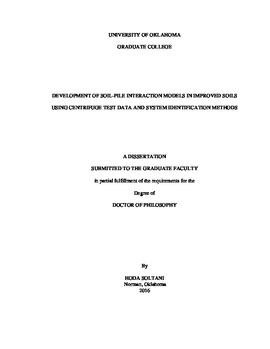| dc.contributor.advisor | Muraleetharan, Kanthasamy | |
| dc.contributor.author | Soltani, Hoda | |
| dc.date.accessioned | 2016-05-12T16:39:35Z | |
| dc.date.available | 2016-05-12T16:39:35Z | |
| dc.date.issued | 2016-05-13 | |
| dc.identifier.uri | https://hdl.handle.net/11244/34641 | |
| dc.description.abstract | Documented distresses in pile foundations in soft soils during past earthquakes have shown that piles founded in soft soils undergo large lateral deformations during seismic loading. Improving the soil surrounding the piles is an effective strategy to improve the behavior of pile foundations in soft soils. Many fundamental mechanisms determining the interaction between the improved soil and piles have, however, not been fully understood. This has led to limited applications of soil improvement around piles in seismic regions and excessive conservatism in designs.
This dissertation assessed the static and seismic responses of single piles in improved and unimproved soft clays using data from a series of centrifuge tests. The centrifuge model contained a number of single piles embedded in a soft clay layer overlying a dense sand layer. The soft clay near the ground surface surrounding some of the piles was improved to various dimensions with cement.
Experimental results were used to extract the p-y curves for both the improved and unimproved soils and these curves were compared with the curves currently used in practice. A new feature was added to the traditional bending moment curve fitting methods accounting for the discontinuities in the distributions of shear force and soil reaction along the piles at the interface between the improved and unimproved soil. The p-y curves currently used in practice were found to be accurate for cases with medium and large improved zones. Although the theory assumes that the p-y curve at a given depth is entirely controlled by soil at that depth, influence of adjacent soil layers were observed on the experimentally derived p-y curves.
System identification methods were employed to extract the natural frequencies, damping ratios, and mode shapes of the unimproved soil system. The identified parameters were validated against those estimated from analytical methods and employed to synthesize prediction models which were subsequently used to simulate the soil response for three successive base motions. The identified models captured acceleration time-histories reasonably well in the small and moderate shaking events. The influence of the improved zone size was reflected on the identified natural frequencies of the soil-pile-top mass systems.
Seismic interactions between the soil and pile were simulated by adapting a hysteretic model that integrated phenomena such as soil-pile separation, material degradation, and radiation damping. The developed interaction elements calibrated for one shaking event were deployed to predict the soil reactions in another shaking event. The predicted soil reactions compared reasonably well with those obtained from the measured results. | en_US |
| dc.language | en_US | en_US |
| dc.subject | Pile Foundations | en_US |
| dc.subject | Soil Improvement | en_US |
| dc.subject | Modal Analysis | en_US |
| dc.subject | Hysteresis | en_US |
| dc.subject | Lateral Loads | en_US |
| dc.title | Development of Soil-Pile Interaction Models in Improved Soils Using Centrifuge Test Data and System Identification Methods | en_US |
| dc.contributor.committeeMember | Runolfsson, Thordur | |
| dc.contributor.committeeMember | Miller, Gerald | |
| dc.contributor.committeeMember | Cerato, Amy | |
| dc.contributor.committeeMember | Sivalingam, Sritharan | |
| dc.date.manuscript | 2016-05-11 | |
| dc.thesis.degree | Ph.D. | en_US |
| ou.group | College of Engineering::School of Civil Engineering and Environmental Science | en_US |
| shareok.nativefileaccess | restricted | en_US |
